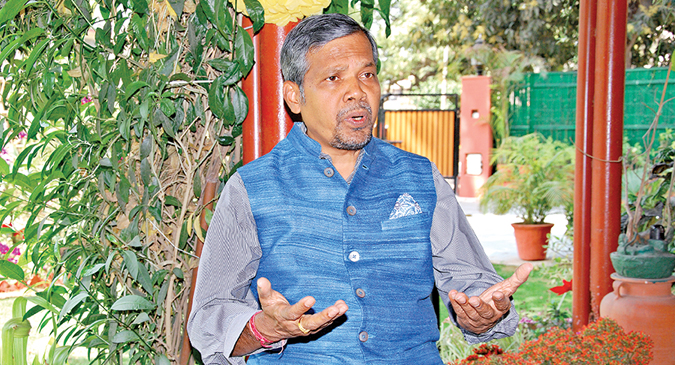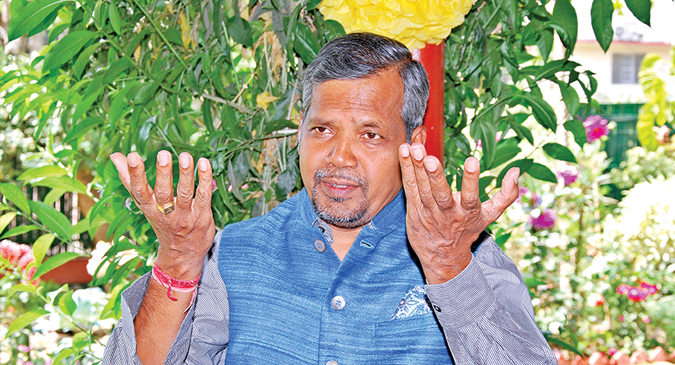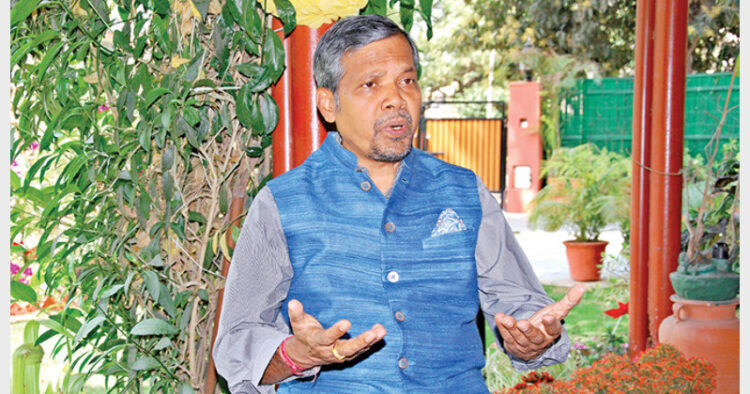The Election Commission of India is one of the most dynamic and time-tested institutions given by the Constitution. Along with other stakeholders, the Commission has always been striving to make the elections not just ‘free & fair’ but also people-friendly. For the upcoming General Elections also, many initiatives are undertaken to face the new challenges like misuse of social media as well as mitigating the old ones like paid & fake news. Former Director General of Election Commission of India Shri Akshay Rout has a candid conversation with Senior Correspondent of Organiser Nishant Kr. Azad. Excerpts:

In your opinion, how is the General Election 2019 going to be different from the previous General Elections?
India’s election journey started in 1951-52. In fact, the election is one of the most wonderful gifts that the Constitution makers have gifted to all of us. Despite the fact that the literacy rate in 1947 was merely 16 per cent, the makers of the Constitution took a bold step to give everyone the right to vote. It is significant because in many countries, including the advanced countries, the voting right came in phases.
In India, every election has been an opportunity to learn something new. In fact, every election has been a challenge. Even then the Election Commission of India (ECI) has given the slogan ‘No voter is to be left behind’. That has been the spirit. Social media was there in 2014, but today it has become a significant challenge. The enforcement of Model of Code of Conduct (MCC), has become more challenging. In 2014, the EC was engaged in an issue called ‘Paid News’, which was a burning issue at that time. Now the new challenge is ‘Fake News’ mostly generated by Social Media.
How has the Election Commission gradually made the election process voters-friendly?
There has been a significant amount of facilitation measures, right from making access to electoral rolls, registration, changes in their parameters, in the electoral roll more friendly with more voter helpline. There is a very active website; 190 helpline is a number which solves all the problem related to vote. For example, if anyone is left behind even after the elections are announced, there are a massive amount of camps for citizens to make sure that within the law people should get a chance to get registered. You can go with a series of alternate ID cards to cast your vote. The EC has put up many guidelines so that a voter can easily find his/her way to the polling station. In the polling station area, minimum basic facilities such as drinking water, first aid kits, area for senior citizens and physically-challenged people have been provided. For women and children, new sheds have been erected. It has been made sure that their entry into the electoral roll is smooth and the entire voting process is smooth and hassle-free.
Any new instrument has to percolate down to the people. To my knowledge, the Election commission of India has a very vibrant outreach programme, in which they reach out to the public in all manners The Commission is moving on three things on what is known as Systematic Voters Educational and Electoral Participation (SVEEP). People are not able to be in the election process because of lack of information, motivation and facilitation. I still recall one of the initial surveys in Jharkhand, where five people did not vote in a particular election. It was found out that 30 per cent people did not vote because they did not have their Voter ID cards. You can still vote. You can use your passport, driving licence or any government approved ID cards. One can happily vote with an alternate identity card.
Even the so-called educated or qualified people cannot think that the information has gone down to the last person. In a country of 1.3 billion population, it is impossible to take the information down to the last person. There are many questions a voter is confronted with such as when is the election, where, what is the date, in which phase, where is the polling station, which button one has to push for NOTA, and so on. So, there have been awareness campaigns. There are demonstrations of VVPAT also.

Next is Motivation. Earlier, many people think what difference does it make if they do not vote. For a significant section of the society, the election day used to be like a holiday. Only old and retired people go to vote, not the youth. Luckily, the situation is changing now. There is more awareness among youth to show the fingers with the voting marks. It has become even ‘fashionable’. A few years back, it was not a matter of pride.
Also, there have been instances of prominent candidates in Rajasthan, Karnataka, Maharashtra losing election by a margin of one vote. Even Vajpayee ji lost his government on the floor of Parliament by one vote. In the last ten years, we have realised the power of a vote. Now people are laso being engaged through cVIGIL.
But most people are not aware of c-VIGIL.
Yes, it is possible, because it works through an app. People must know, and make use of the app. Perhaps, use of this app is not as much as you or the EC expect it to be. But the results through cVIGIL have been very encouraging. Any new instrument we talked just now has to percolate down to the people. To my knowledge, the EC has a very vibrant outreach programme, in which they reach out to the public in all manners.
Interestingly, the Commission has to do much micromanagement. First, they have to reach out to the electorates. To reach out to everyone is a challenging task. VVPAT is not as old as EVM, and EVM is not as old as regular ballot-based voting. But now people are entirely aware of voting. NOTA (None Of The Above) was started. So, it took time for the people to know about it. Similarly, cVIGIL app also is a mechanism to get feedback and to curb the malpractices. It is not for the citizens. It is more for the benefit of the election management authorities. But citizens are given a stake in this. Citizens are getting involved in it. It is an alternative mechanism for the EC to curb the malpractices.
Some opposition parties, repeatedly but selectively, allege tampering with the EVMs. What do you think about it?
EVMs were introduced over a period of time with due test and care. It is regarded as one of the beautiful gifts of the Indian Election system to the whole world. Countries after countries come to India to see the working of the EVMs so that they can adapt it to the way they want.
We are a big country. We talk about 90 crore electorates. Just imagine! Remember the things happening in the past at the time of ballot-box voting. It was very complicated. It used to take so much time for voting and days for counting. There will be more invalid votes, mutilation, fudging and ballots not put in a proper manner and so many other complications. Then ‘booth-capturing business’, ballot-boxes being taken away were also there. You can take away the EVM, but you cannot do anything with it. You can burn it. You can put it in water. But you cannot change anything that is inside.
And then, of course, any environmentalist would say how much paper is saved. So, for this great game of numbers, this instrument of voting has been evolved by public sector companies under the guidance and constant vigil of an adequately constituted team of top-level technocrats. It has legal and technological sanctions. Also, it has physical security. The EVMs are guarded, from remote polling stations—where it is kept, when it is used, when it is taken back, and where it is preserved. So we have technological security, legal security. It also has the backing of the court, and we have also the physical security. So, with all this, now there is no doubt that EVMs are non-tamperable and transparent. Nothing can be altered or changed either directly or remotely. It has stood judicial and political scrutiny. It has stood actual tampering by people. No one can hack or tamper with it.
The introduction of VVPAT does not mean any undermining of EVMs. VVPAT is just another layer of verifiability so that people may have the satisfaction of looking at whom they have voted. They see it on a slip of paper under glass. So that’s just a method of verifiability. So all polling stations are covered by this verifiability. It gives you the satisfaction of what has been put in it. 100 per cent polling stations are covered by the verifiability. So it should give another level of satisfaction and joy to the people who vote. You can see the candidate and who have voted for him. VVPAT allows a good seven seconds to view it. Overall, the system is quite secure. If you look at the history of EVMs in the past elections, you can see that all kinds of different parties have been winning. Every time a different party wins. I perhaps think there is no need to waste our time about discussing tampering with the EVMs. I don’t think any political party or candidate has any serious doubt about EVMs. It may come up for debate once in a while. Maybe VVPAT is relatively new. Some discussion is going on about how much the VVPAT count should be matched against the actual slips. As people are getting used to the EVMs, even that debate will be over.
Hundred per cent VVPATs are to be ensured in these general elections. Do you think it is due to pressure from opposition parties or it is part of the routine process of EC to ensure free and fair polls?
Yes! In my view, the EC is continuously engaged in improving its methods and processes. The existing procedures and instruments are globally recognised. They are among the best. Still, ours is a hugely responsible constitutional organisation. The Commission is engaged in the process of improving its parameters. I don’t think the word pressure will apply in this context. The Commission holds itself responsible to the Constitution of India and the people of India. And also to the political parties of India as they are one of the stakeholders. If a suggestion is coming from anywhere, be it political parties, citizens, that is heard seriously.
In fact, one of the beautiful things with the EC is that it does very extensive consultation with all stakeholders. Whether they are making a small change or introducing electoral reforms, it makes many consultations. Before any General Elections take place, one would have seen that they make so many consultations. And in that they take inputs, they feel responsible and they fulfil their duty to respond to the suggestions. Even from political parties. When the system is put in place after the consultation, the most important thing is that they enforce it very vigorously. This makes the EC working significantly.
When it comes to digital or social media, the EC’s Model Code of Conduct seems ineffective. How is the EC addressing this issue?
In the 2019 election, one of the significant factors is social media. We have stopped talking positively about social media in the context of election management. That is an irony. Because Social Media should have a good use for both dissemination of right information to the voters, motivational information for voters and facilities created for them and from the political parties’ point of view to disseminate information about their legitimate political campaign. These are good things about social media, but good things are not discussed anymore. Because it has become so difficult, it has created so much illegal interference. Yes, it is a big challenge. Because I think in an election season, the violators of the law, MCC, section 126 of the RP Act, which relates to display of anything related to the election campaign, and the observance of Silent Hours – 48 hours of silence before the closure of Election. All of these are extremely important. But in social media, there has been a tendency and a dangerous possibility of a violation. There are some violations, which are difficult to catch because of anonymity. The footprints are not very clear; the trails are difficult to follow. It is a big challenge. There are anonymous players in remote locations which cannot be identified or traced immediately to file an FIR or take an action.
NRIs have been demanding voting rights. The registration process was also started. Any progress on that front?
Well, the registration process has been made much simpler for them. NRI who would like to vote are now more-friendly. Now the NRI registration is also going up. But it has been clarified that for voting, they have to vote where they should normally vote.
There are demands for e-voting from some time. Your take.
Some suggestions have come regarding e-voting, but there are some problems too. There is an aspect of secrecy, free, fair and influence-free voting and I think within the present arrangement they are supposed to vote where the polling station is.













Comments